How is this a Continuing Issue?
While some progress has been made in recent years due to regulations and better containment techniques (in the form of higher-quality equipment, new recovery technologies, etc), there is still more to be done. This is still a recurring problem – the effects of which are environmentally, economically, and socially catastrophic.
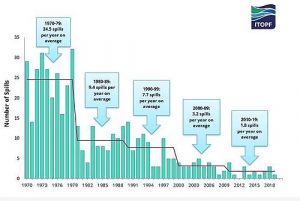
The number of oil spills has decreased from an average of 25 accidents per year in the 1970s to about 1-4 within the past decade (Leahy, 2019). However, the magnitude of each oil spill and the extent of the effects are detrimental so even one is one too many.
For example, in the North Slope alone between 2006-2009, over 660,000 gallons were spilled (PEW Environment Group, 2020) – the largest of which occurred in March 2006 when the Trans-Atlantic Pipeline System (TAPS) leaked due to corrosion. Over 276,000 gallons poured out of a section in the Prudhoe Bay oil fields for five days before discovery (Knickerbocker, 2006).
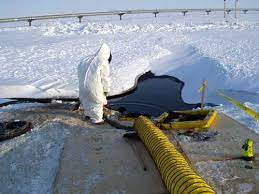
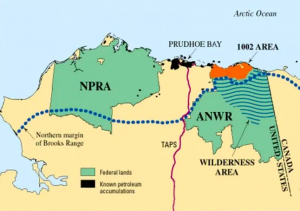
Not only are oil spills continuing, there is a potential for an increase in spills as recent movements to increase drilling in Alaska have been rising (i.e. Trump’s Tax Cuts and Jobs Act of 2017). Additionally, the disappearance of sea ice due to climate change is opening up more waters for shipping routes, leading to a greater risk for oil spills.
Why should We Care?
Oil spills hold devastating impacts on the environment and surrounding communities:
- Environmentally: through the loss of wildlife (both plants and animals) due to fouling – the process of organisms being smothered in oil – and oil toxicity (NOAA, 2020).
- Economically: through the collapse of fisheries, due to lack of wildlife in the area and the diversion of fishing boats/resources for cleanup, and the loss of tourism activity and recreation (Struck, 2009). As these are focal points of Alaskan coastal towns’ economies, this results in a major loss of revenue (EVOS Trustee Council, 2020).
- Socially: through the contamination and loss of a major subsistence resource for local native populations – fishing. This constitutes a health concern, causing food security to be lagging in quantity and quality (Leahy, 2019).
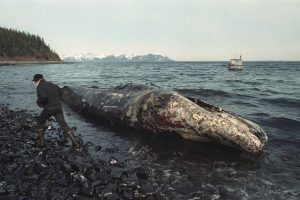

“It’s quiet in Prince William Sound… the ecosystem took one hell of a hit” ~testimony from a local fisherman after the Valdez spill
What Do We Know?
Research on the effects on the issue of oil spills within the Arctic is ongoing, explored by concerned citizens, nongovernmental organizations, countries, and oil companies alike. Knowledge is limited, and will only increase in the future, as the full extent of oil spills are still being discovered as long-term effects are becoming more apparent every day.
For example, the delayed impacts of fisheries never returning to their full original glory on economies and the struggling recovery of animal species – interdependent on each other’s success because of food chains (Struck, 2009). Additionally, the discovery of how gallons of oil remain in pockets in pits dug into the surfaces of shores means these environments are still being harmed, even decades later.
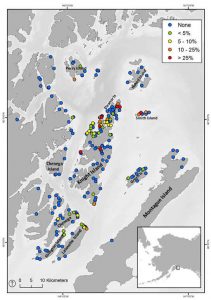
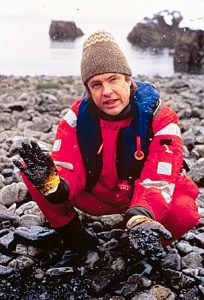
(Left): A map of oil spots leftover from the Valdez
(Right): A scientist discovers subsurface oil beneath a seemingly clean beach in Prince William Sound
Knowledge is also limited because it is hard to discern the potential impacts of oil spills from other economic, environmental factors – such as increased sport-fishing or climate change warming the waters and affects levels of salinity: all factors which could result in the loss of wildlife or crashing of fishing industries (EVOS Trustee Council, 2019).
What Has Been Done?
In recent years, there have been some developments meant to improve contingency plans for oil spills in Alaska, as well as the quality of response equipment and preventative regulations. The largest of which was the Oil Pollution Act of 1990, passed after the Exxon Valdez spill in 1989. What did this act do? It…
- Required all oil tankers in the US have a double hull to make it less likely a collision would result in a spill
- Increased penalties for companies responsible for oil spills with the Oil Spill Liability Trust Fund – ensuring victims are compensated by the polluters
- Strengthened spill disaster plans by requiring all companies operating in US Arctic waters establish new contingency plans
What More Could You Do?
While there has been some progress made, the issue continues. We need to take more proactive steps, as opposed to reactive, in order to make substantial change. That is why we argue for the complete ban of oil drilling and use in the Arctic by 2040 – a radical change that will yield radical results. By getting rid of oil drilling and use, we are eliminating the risk of oil spills and all the harmful effects they can have.
A completely effective response is limited so long as Alaska, and the rest of the Arctic, tries to walk the line between economic growth and environmental protection. As one oil spill consultant and marine biologist says…
“The only real way to eliminate the risks to the environment is to get off of oil… as long as we are going to be using this stuff, we are going to be spilling it. It goes with the territory”
However, there are other ways to alleviate the issue in the meantime. In addition to taking measures to support that bill, you can write letters to your legislators to help spread awareness of the issue(s) and advocate for the following policies:
- The establishment of minimum vessel manning requirements, creating an agency-wide requirement of people proportionate to the amount of gallons on board
- Linking oil spill prevention and response with preparedness for other hazardous substance intoxication (i.e. PFAS, acid, antifreeze) to increase funds, achieved by broadening the tax base to collect revenue from other non-oil industries
- Requiring better maintenance of pipelines, holding companies accountable and increasing corporate liability to incentivize change
Plus, educate yourself further by watching the video below, detailing this issue!
[ensemblevideo version=”5.6.0″ content_type=”video” id=”3ff00462-0408-48cc-830f-c6fb2f5f70a2″ width=”848″ height=”480″ displaytitle=”true” autoplay=”false” showcaptions=”false” hidecontrols=”true” displaysharing=”false” displaycaptionsearch=”true” displayattachments=”true” audiopreviewimage=”true” isaudio=”false” displaylinks=”true” displaymetadata=”false” displaydateproduced=”true” displayembedcode=”false” displaydownloadicon=”false” displayviewersreport=”false” embedasthumbnail=”false” displayaxdxs=”false” embedtype=”responsive” forceembedtype=”false” name=”Oil Spill Prevention & Preparedness in Alaska – Hajna Nagy”]
Visit our ‘How to Get Involved’ and ‘How to Learn More’ for more information!